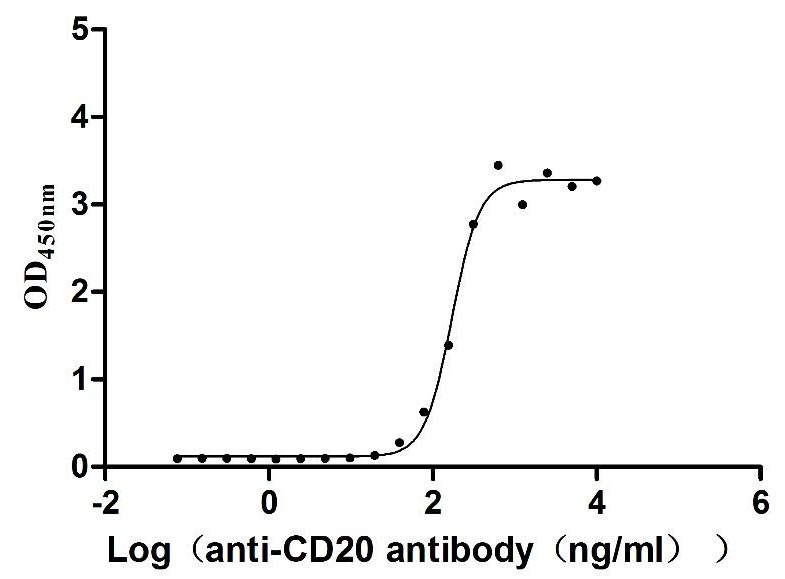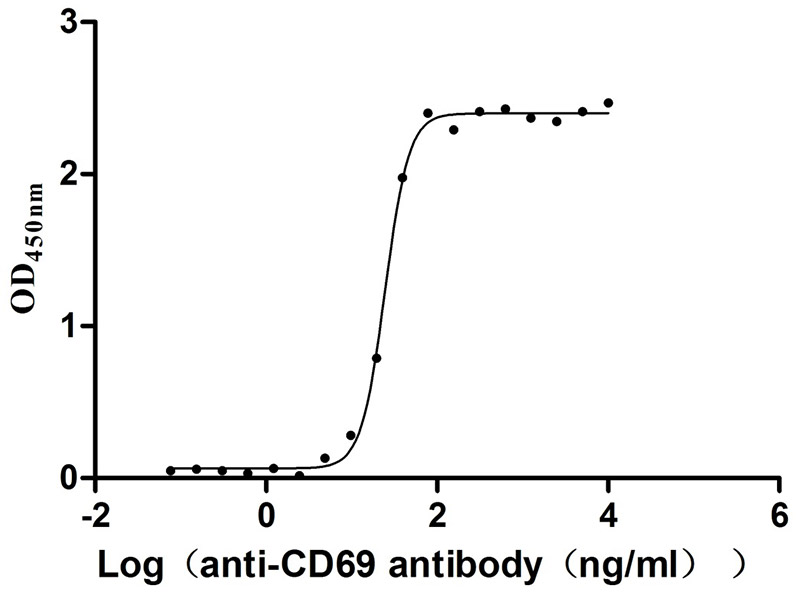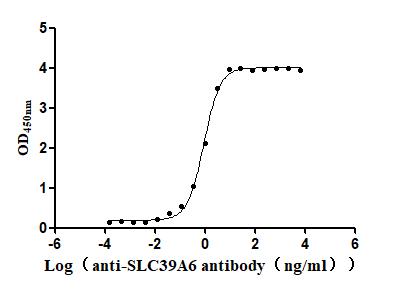Recombinant Mouse Sortilin-related receptor (Sorl1), partial
-
中文名稱:小鼠Sorl1重組蛋白
-
貨號:CSB-EP022411MO-B
-
說明書:
-
規格:
-
來源:E.coli
-
共軛:Avi-tag Biotinylated
E. coli biotin ligase (BirA) is highly specific in covalently attaching biotin to the 15 amino acid AviTag peptide. This recombinant protein was biotinylated in vivo by AviTag-BirA technology, which method is BriA catalyzes amide linkage between the biotin and the specific lysine of the AviTag.
-
其他:
產品詳情
-
純度:>85% (SDS-PAGE)
-
基因名:Sorl1
-
Uniprot No.:
-
別名:Sorl1; Sortilin-related receptor; Gp250; Low-density lipoprotein receptor relative with 11 ligand-binding repeats; LDLR relative with 11 ligand-binding repeats; LR11; SorLA-1; Sorting protein-related receptor containing LDLR class A repeats; mSorLA
-
種屬:Mus musculus (Mouse)
-
蛋白長度:Partial
-
蛋白標簽:Tag?type?will?be?determined?during?the?manufacturing?process.
The tag type will be determined during production process. If you have specified tag type, please tell us and we will develop the specified tag preferentially. -
產品提供形式:Lyophilized powder Warning: in_array() expects parameter 2 to be array, null given in /www/web/cusabio_cn/public_html/caches/caches_template/default/content/show_product_protein.php on line 662
Note: We will preferentially ship the format that we have in stock, however, if you have any special requirement for the format, please remark your requirement when placing the order, we will prepare according to your demand. -
復溶:We recommend that this vial be briefly centrifuged prior to opening to bring the contents to the bottom. Please reconstitute protein in deionized sterile water to a concentration of 0.1-1.0 mg/mL.We recommend to add 5-50% of glycerol (final concentration) and aliquot for long-term storage at -20℃/-80℃. Our default final concentration of glycerol is 50%. Customers could use it as reference.
-
儲存條件:Store at -20°C/-80°C upon receipt, aliquoting is necessary for mutiple use. Avoid repeated freeze-thaw cycles.
-
保質期:The shelf life is related to many factors, storage state, buffer ingredients, storage temperature and the stability of the protein itself.
Generally, the shelf life of liquid form is 6 months at -20°C/-80°C. The shelf life of lyophilized form is 12 months at -20°C/-80°C. -
貨期:Delivery time may differ from different purchasing way or location, please kindly consult your local distributors for specific delivery time.Note: All of our proteins are default shipped with normal blue ice packs, if you request to ship with dry ice, please communicate with us in advance and extra fees will be charged.
-
注意事項:Repeated freezing and thawing is not recommended. Store working aliquots at 4°C for up to one week.
-
Datasheet :Please contact us to get it.
靶點詳情
-
功能:Sorting receptor that directs several proteins to their correct location within the cell. Along with AP-1 complex, involved Golgi apparatus - endosome sorting. Sorting receptor for APP, regulating its intracellular trafficking and processing into amyloidogenic-beta peptides. Retains APP in the trans-Golgi network, hence preventing its transit through late endosomes where amyloid beta peptides Abeta40 and Abeta42 are generated. May also sort newly produced amyloid-beta peptides to lysosomes for catabolism. Does not affect APP trafficking from the endoplasmic reticulum to Golgi compartments. Sorting receptor for the BDNF receptor NTRK2/TRKB that facilitates NTRK2 trafficking between synaptic plasma membranes, postsynaptic densities and cell soma, hence positively regulates BDNF signaling by controlling the intracellular location of its receptor. Sorting receptor for GDNF that promotes GDNF regulated, but not constitutive secretion. Sorting receptor for the GDNF-GFRA1 complex, directing it from the cell surface to endosomes. GDNF is then targeted to lysosomes and degraded, while its receptor GFRA1 recycles back to the cell membrane, resulting in a GDNF clearance pathway. The SORL1-GFRA1 complex further targets RET for endocytosis, but not for degradation, affecting GDNF-induced neurotrophic activities. Sorting receptor for ERBB2/HER2. Regulates ERBB2 subcellular distribution by promoting its recycling after internalization from endosomes back to the plasma membrane, hence stimulating phosphoinositide 3-kinase (PI3K)-dependent ERBB2 signaling. Sorting receptor for lipoprotein lipase LPL. Promotes LPL localization to endosomes and later to the lysosomes, leading to degradation of newly synthesized LPL. Potential sorting receptor for APOA5, inducing APOA5 internalization to early endosomes, then to late endosomes, wherefrom a portion is sent to lysosomes and degradation, another portion is sorted to the trans-Golgi network. Sorting receptor for the insulin receptor INSR. Promotes recycling of internalized INSR via the Golgi apparatus back to the cell surface, thereby preventing lysosomal INSR catabolism, increasing INSR cell surface expression and strengthening insulin signal reception in adipose tissue. Does not affect INSR internalization. Plays a role in renal ion homeostasis, controlling the phospho-regulation of SLC12A1/NKCC2 by STK39/SPAK kinase and PPP3CB/calcineurin A beta phosphatase, possibly through intracellular sorting of STK39 and PPP3CB. Stimulates, via the N-terminal ectodomain, the proliferation and migration of smooth muscle cells, possibly by increasing cell surface expression of the urokinase receptor uPAR/PLAUR. This may promote extracellular matrix proteolysis and hence facilitate cell migration. By acting on the migration of intimal smooth muscle cells, may accelerate intimal thickening following vascular injury. Promotes adhesion of monocytes. Stimulates proliferation and migration of monocytes/macrophages. Through its action on intimal smooth muscle cells and macrophages, may accelerate intimal thickening and macrophage foam cell formation in the process of atherosclerosis. Regulates hypoxia-enhanced adhesion of hematopoietic stem and progenitor cells to the bone marrow stromal cells via a PLAUR-mediated pathway. This function is mediated by the N-terminal ectodomain. Metabolic regulator, which functions to maintain the adequate balance between lipid storage and oxidation in response to changing environmental conditions, such as temperature and diet. The N-terminal ectodomain negatively regulates adipose tissue energy expenditure, acting through the inhibition the BMP/Smad pathway. May regulate signaling by the heterodimeric neurotrophic cytokine CLCF1-CRLF1 bound to the CNTFR receptor by promoting the endocytosis of the tripartite complex CLCF1-CRLF1-CNTFR and lysosomal degradation. May regulate IL6 signaling, decreasing cis signaling, possibly by interfering with IL6-binding to membrane-bound IL6R, while up-regulating trans signaling via soluble IL6R.
-
基因功能參考文獻:
- These results demonstrate a novel role for SORLA as a physiological and pathological EphA4 modulator. PMID: 29114064
- Results demonstrate that the lack of SORLA results in accumulation of phosphorylated synapsins in cortex and hippocampus. Authors propose an underlying molecular mechanism by demonstrating that SORLA interacts with phosphorylated synapsins through 14-3-3 adaptor proteins to deliver synapsins to calpain-mediated proteolytic degradation. PMID: 27021222
- Analysis of the molecular mechanism for the association of SORL1 with obesity: there is a genetic link between neurodegeneration and metabolism that converges on the receptor SORLA PMID: 27322061
- SorLA ectodomain, released from the cell membrane upon enzymatic cleavage of full-length SorLA, may act as an IL-6 carrier protein that stabilizes IL-6 and its capacity for trans signaling. PMID: 28265003
- We identify binding and trafficking interactions between two of these factors, SORLA and SNX27, and demonstrate that SNX27 can direct trafficking of SORLA and the Abeta precursor APP to the cell surface to limit the production of Abeta. Diversion APP to the cell surface through modulation of this molecular complex may represent a complimentary strategy for future development in AD treatment. PMID: 27466343
- LR11 regulated vascular smooth muscle cell proliferation during the progression of hypoxia-induced medial thickening in mice. PMID: 27493099
- Therefore, SORL1 activation by 6-shogaol provides neuronal cell survival through the inhibition of Abeta production. These results indicate that 6-shogaol should be regarded as an SORL1 activator and a potential preventive agent for the treatment of AD. PMID: 28188785
- Data strongly suggest an involvement of LR11 in mediating the harmful effects of a high-fat diet on CVD progression. PMID: 26520897
- Mice lacking LR11 are protected from diet-induced obesity associated with an increased browning of white adipose tissue and hypermetabolism. PMID: 26584636
- using massively parallel reporter assays, we dissect the enhancer activity of three liver eExons (SORL1 exon 17, TRAF3IP2 exon 2, PPARG exon 6) at single nucleotide resolution in the mouse liver PMID: 25340400
- Data indicate that activation of alpha(2A) adrenergic receptor (alpha(2A)AR) signaling disrupts transgenic amyloid precursor protein (APP) interaction with sorting-related receptor with A repeat (SorLA) in cells and brain. PMID: 25404298
- SORLA-mediated trafficking of TrkB enhances the response of neurons to BDNF. PMID: 23977241
- SorLA acts as sorting receptor for the GDNF/GFRalpha1 complex, directing it from the cell surface to endosomes. PMID: 23333276
- sLR11 regulates the hypoxia-enhanced adhesion of HSPCs via an uPAR-mediated pathway that stabilizes the hematological pool size by controlling cell attachment to the BM niche. PMID: 23486467
- SorLA expression might be critical not only for amyloid-related pathology but also for other cellular processes altered in Alzheimer disease. PMID: 22986780
- overexpression of SorLA increased migration of THP-1 monocytes to monocyte chemoattractant protein-1 with a coincident increase in UPAR expression. PMID: 20970138
- Sorcs1 deficiency might be a common genetic risk factor underlying the predisposition to Alzheimer disease that is associated with type 2 diabetes. PMID: 20881129
- These findings demonstrate that the beneficial effects ascribed to BDNF in APP metabolism act through induction of Sorla that encodes a negative regulator of neuronal APP processing. PMID: 20007471
- LR11, which is expressed in the intimal SMCs, is important in the process of the migration and proliferation of SMCs in vivo. PMID: 14764453
- SorLA/LR11 N-linked oligosaccharides are modified with terminal GalNAc-4-SO4 in kidney and brain PMID: 17121844
- documented a role for SORLA not only in control of plaque burden but also in amyloid precursor protein-dependent neuronal signaling PMID: 18362153
- Ang II-stimulated migration of vascular smooth muscle cells is dependent on LR11 in mice. PMID: 18618022
- The results of the current study support the hypothesis that control of LR11 expression may exert critical effects on Alzheimer's disease susceptibility in humans. PMID: 19036982
顯示更多
收起更多
-
亞細胞定位:Golgi apparatus membrane; Single-pass type I membrane protein. Golgi apparatus, trans-Golgi network membrane; Single-pass type I membrane protein. Endosome membrane; Single-pass type I membrane protein. Early endosome membrane; Single-pass type I membrane protein. Recycling endosome membrane; Single-pass type I membrane protein. Endoplasmic reticulum membrane; Single-pass type I membrane protein. Endosome, multivesicular body membrane; Single-pass type I membrane protein. Cell membrane; Single-pass type I membrane protein. Cytoplasmic vesicle, secretory vesicle membrane; Single-pass type I membrane protein. Secreted.
-
蛋白家族:VPS10-related sortilin family, SORL1 subfamily
-
組織特異性:Highly expressed in the central nervous system, including in the brain and spinal cord, in neurons, as well as in glial cells (at protein level). In the brain, mainly expressed in the cerebellum, hippocampus, dentate gyrus, hypothalamus, and in the cerebr
-
數據庫鏈接:
Most popular with customers
-
Recombinant Human CD40 ligand (CD40LG), partial (Active)
Express system: Mammalian cell
Species: Homo sapiens (Human)
-
Recombinant Human papillomavirus type 16 Protein E7 (E7) (Active)
Express system: E.coli
Species: Human papillomavirus type 16
-
Recombinant Human Cytokine receptor common subunit beta (CSF2RB), partial (Active)
Express system: Mammalian cell
Species: Homo sapiens (Human)
-
Recombinant Dog B-lymphocyte antigen CD20 (MS4A1)-VLPs (Active)
Express system: Mammalian cell
Species: Canis lupus familiaris (Dog) (Canis familiaris)
-
Recombinant Human Early activation antigen CD69 (CD69), partial (Active)
Express system: Mammalian cell
Species: Homo sapiens (Human)
-
Recombinant Macaca fascicularis Gastric inhibitory polypeptide receptor (GIPR), partial (Active)
Express system: yeast
Species: Macaca fascicularis (Crab-eating macaque) (Cynomolgus monkey)
-
Recombinant Macaca fascicularis Zinc transporter ZIP6 isoform X1(SLC39A6),partial (Active)
Express system: Baculovirus
Species: Macaca fascicularis (Crab-eating macaque) (Cynomolgus monkey)
-
Express system: Mammalian cell
Species: Homo sapiens (Human)



















